Janet Roberts's Blog, page 13
June 5, 2014
Belvoir Hunt Kennels Open Day - Leicestershire
http://www.aboutnottinghamshire.co.uk/
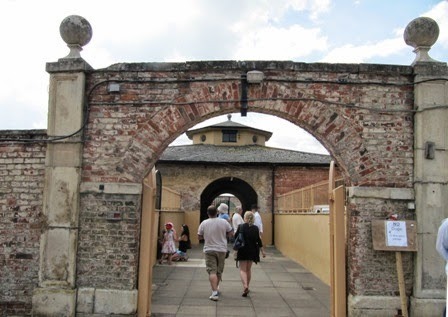 There have been hunting dogs at Belvoir Castle since 1809, and in fact are one of very few remaining packs of purebred Old English Foxhounds in the country. The pack currently consists of 48 couples.
There have been hunting dogs at Belvoir Castle since 1809, and in fact are one of very few remaining packs of purebred Old English Foxhounds in the country. The pack currently consists of 48 couples.
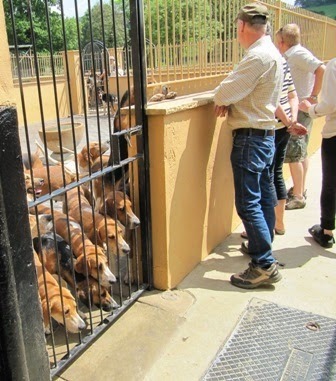 It was exciting just to drive down the 'Private Road' to get to the kennels - clearly this was a treat only occasionally available. The immediate impression was both of the vast scale of the place, and the utter cleanliness. This is the entrance to the kennel complex, and whilst the big dogs were vaguely interested in all the people, they were so incredibly quiet and contented - unlike the masses of visiting dogs, who were all barking and running around excitedly. There were a number of big pens and the dogs were lying around dozing in the sunshine.
It was exciting just to drive down the 'Private Road' to get to the kennels - clearly this was a treat only occasionally available. The immediate impression was both of the vast scale of the place, and the utter cleanliness. This is the entrance to the kennel complex, and whilst the big dogs were vaguely interested in all the people, they were so incredibly quiet and contented - unlike the masses of visiting dogs, who were all barking and running around excitedly. There were a number of big pens and the dogs were lying around dozing in the sunshine.
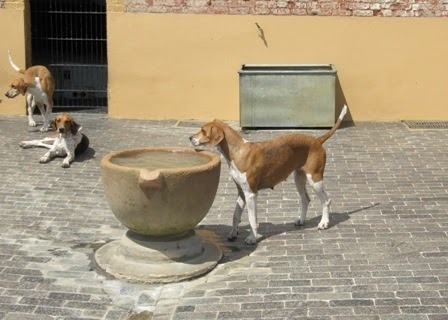
 Away from the main pens were a group containing young puppies, who were of course absolutely gorgeous and were all in a heap together. Further along, in a quiet area which you could only see from a distance, were tiny new-borns suckling from the docile bitches.
Away from the main pens were a group containing young puppies, who were of course absolutely gorgeous and were all in a heap together. Further along, in a quiet area which you could only see from a distance, were tiny new-borns suckling from the docile bitches.
I n the field against the kennels were numerous, very popular dog show events, and even a Fun Class for things like 'Waggiest Tail' and 'Best Sausage Catcher'. This certainly drew the crowds.
n the field against the kennels were numerous, very popular dog show events, and even a Fun Class for things like 'Waggiest Tail' and 'Best Sausage Catcher'. This certainly drew the crowds.
Something that really interested me was watching the skilled farrier at work. Inside the van of W. Spence and Son was a furnace, and all the equipment like the anvil and hammers. On a hot day it was really hard physical work, but absolutely fascinating to watch.

Then it was off to watch the sheep shearing demo provided by Geoff Rogerson, another hard job in the boiling sun. It was unbelievable that he could shear a complete sheep in just over a minute.
As if all this wasn't enough, I then strolled out into the beautiful Park itself, and stood and watched Carriage Driving, part of the Midlands Driving Trials. I'd seen carriage driving before, but always at high speed dashing round an arena. This was quite different, with the carriages being taken through the countryside. On such a beautiful day, with the rhododendrons in full flower, I couldn't think of a nicer way to spend the first day of June.
The only thing I must remember if I go again next year is to take a picnic as there was little available in the way of refreshment, but that was the only criticism of a truly memorable day.

 There have been hunting dogs at Belvoir Castle since 1809, and in fact are one of very few remaining packs of purebred Old English Foxhounds in the country. The pack currently consists of 48 couples.
There have been hunting dogs at Belvoir Castle since 1809, and in fact are one of very few remaining packs of purebred Old English Foxhounds in the country. The pack currently consists of 48 couples. It was exciting just to drive down the 'Private Road' to get to the kennels - clearly this was a treat only occasionally available. The immediate impression was both of the vast scale of the place, and the utter cleanliness. This is the entrance to the kennel complex, and whilst the big dogs were vaguely interested in all the people, they were so incredibly quiet and contented - unlike the masses of visiting dogs, who were all barking and running around excitedly. There were a number of big pens and the dogs were lying around dozing in the sunshine.
It was exciting just to drive down the 'Private Road' to get to the kennels - clearly this was a treat only occasionally available. The immediate impression was both of the vast scale of the place, and the utter cleanliness. This is the entrance to the kennel complex, and whilst the big dogs were vaguely interested in all the people, they were so incredibly quiet and contented - unlike the masses of visiting dogs, who were all barking and running around excitedly. There were a number of big pens and the dogs were lying around dozing in the sunshine.
 Away from the main pens were a group containing young puppies, who were of course absolutely gorgeous and were all in a heap together. Further along, in a quiet area which you could only see from a distance, were tiny new-borns suckling from the docile bitches.
Away from the main pens were a group containing young puppies, who were of course absolutely gorgeous and were all in a heap together. Further along, in a quiet area which you could only see from a distance, were tiny new-borns suckling from the docile bitches.I
 n the field against the kennels were numerous, very popular dog show events, and even a Fun Class for things like 'Waggiest Tail' and 'Best Sausage Catcher'. This certainly drew the crowds.
n the field against the kennels were numerous, very popular dog show events, and even a Fun Class for things like 'Waggiest Tail' and 'Best Sausage Catcher'. This certainly drew the crowds.Something that really interested me was watching the skilled farrier at work. Inside the van of W. Spence and Son was a furnace, and all the equipment like the anvil and hammers. On a hot day it was really hard physical work, but absolutely fascinating to watch.

Then it was off to watch the sheep shearing demo provided by Geoff Rogerson, another hard job in the boiling sun. It was unbelievable that he could shear a complete sheep in just over a minute.
As if all this wasn't enough, I then strolled out into the beautiful Park itself, and stood and watched Carriage Driving, part of the Midlands Driving Trials. I'd seen carriage driving before, but always at high speed dashing round an arena. This was quite different, with the carriages being taken through the countryside. On such a beautiful day, with the rhododendrons in full flower, I couldn't think of a nicer way to spend the first day of June.
The only thing I must remember if I go again next year is to take a picnic as there was little available in the way of refreshment, but that was the only criticism of a truly memorable day.

Published on June 05, 2014 09:06
June 2, 2014
Rogation Sunday - Laxton - Nottinghamshire
http://www.aboutnottinghamshire.co.uk/
Rogation Sunday is traditionally the 5th Sunday after Easter, and is for the blessing of the new crops and in the hope of a fruitful season. When I heard there was to be such a service in the delightful little village of Laxton (see previous blog) I just had to attend.
Normally these services are held outside, and sometimes involve 'beating the boundaries' of the fields, but this year it was so wet it was decided to hold the service inside in the lovely little church.
We started with an Invitation to Worship (from The Song of Songs)
See the winter is past:
the snows are over and gone.
Flowers appear on the earth;
the season of singing has come.
The trees are beginning to bud;
the blossom has spread its fragrance.
The cry of the birds is heard in our land;
Arise, come and worship. Amen
During the service we sung rousing hymns like 'Morning has broken, like the first morning...' and 'For the beauty of the earth, for the beauty of the skies...'
One of the prayers contained these words:
'Heavenly Father, as you have taught us to pray for our daily bread and to recognize our dependence on your bounty, so we ask your blessing on the sowing of the seed and the labours of those who work on the land; that the earth may yeild its full harvest and the needs of all men may be supplied. Through Jesus Christ our Lord. Amen'
Then there was the Rogation Covenant
Brothers and sisters, we covenant today with one another;
With every living creature and all on which we depend.
With all that is on earth and with earth itself.
With all that lives in the waters and with waters themselves. With all creatures of the air, and with the air itself.
With all that is warm with life, and with the living fire.
We commit ourselves today to put away all selfishness and greed and to embrace one another in love and joy and peace.
The is was followed by the Rogation Blessings
The bloessing of God be on the plants in our fields, that they may produce a boutiful harvest in due searon, vegetables, fruit and grain to feed us, flowers, shrubs and trees to gladden our eyes.
The blessing God be on all the animals upon our farms.
The blessing of God be on all who work on our farms, small-holding and nurseries.
The blessing of God be on our parishes, on all who live and work here. Amen.
I thought this a really lovely service, and was so glad I'd attended, even it we had to be inside. Perhaps next year it will be possible to hold the service in the fields - now that would be something rather special.

Rogation Sunday is traditionally the 5th Sunday after Easter, and is for the blessing of the new crops and in the hope of a fruitful season. When I heard there was to be such a service in the delightful little village of Laxton (see previous blog) I just had to attend.
Normally these services are held outside, and sometimes involve 'beating the boundaries' of the fields, but this year it was so wet it was decided to hold the service inside in the lovely little church.
We started with an Invitation to Worship (from The Song of Songs)
See the winter is past:
the snows are over and gone.
Flowers appear on the earth;
the season of singing has come.
The trees are beginning to bud;
the blossom has spread its fragrance.
The cry of the birds is heard in our land;
Arise, come and worship. Amen
During the service we sung rousing hymns like 'Morning has broken, like the first morning...' and 'For the beauty of the earth, for the beauty of the skies...'
One of the prayers contained these words:
'Heavenly Father, as you have taught us to pray for our daily bread and to recognize our dependence on your bounty, so we ask your blessing on the sowing of the seed and the labours of those who work on the land; that the earth may yeild its full harvest and the needs of all men may be supplied. Through Jesus Christ our Lord. Amen'
Then there was the Rogation Covenant
Brothers and sisters, we covenant today with one another;
With every living creature and all on which we depend.
With all that is on earth and with earth itself.
With all that lives in the waters and with waters themselves. With all creatures of the air, and with the air itself.
With all that is warm with life, and with the living fire.
We commit ourselves today to put away all selfishness and greed and to embrace one another in love and joy and peace.
The is was followed by the Rogation Blessings
The bloessing of God be on the plants in our fields, that they may produce a boutiful harvest in due searon, vegetables, fruit and grain to feed us, flowers, shrubs and trees to gladden our eyes.
The blessing God be on all the animals upon our farms.
The blessing of God be on all who work on our farms, small-holding and nurseries.
The blessing of God be on our parishes, on all who live and work here. Amen.
I thought this a really lovely service, and was so glad I'd attended, even it we had to be inside. Perhaps next year it will be possible to hold the service in the fields - now that would be something rather special.

Published on June 02, 2014 23:49
May 24, 2014
Chatsworth in Wartime - Derbyshire
http://www.aboutnottinghamshire.co.uk/
From the many blogs I've written about Chatsworth House, regular readers of my blog will appreciate that I love the place, and can never believe how inventive they are - so you just have to keep going back in order to see what's new!
When I visited the Floramania show (see previous blog)
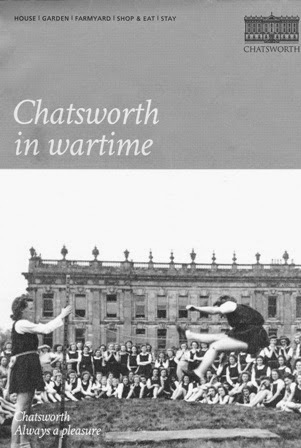 I was handed a leaflet entitled 'Chatsworth in wartime' and how interesting it was! It explained how the Duke of Devonshire realised that during the Second World War the House would be needed for the war effort, and thought school girls would be better than having servicemen move in - undoubtedly sound reasoning! Consequently 250 girls from Penrhos College in Wales arrived in 1939 - and stayed until 1946.
I was handed a leaflet entitled 'Chatsworth in wartime' and how interesting it was! It explained how the Duke of Devonshire realised that during the Second World War the House would be needed for the war effort, and thought school girls would be better than having servicemen move in - undoubtedly sound reasoning! Consequently 250 girls from Penrhos College in Wales arrived in 1939 - and stayed until 1946.
The glorious Painted Hall was used for assemblies and singing lessons - what a marvellous experience it must have been!
Accommodating the girls proved a challenge but the Chatsworth staff managed to achieve it in just 11 days, putting as much as possible into storage, and covering large items with dust sheets. The leaflet describes how the Dowager Duchess would often show American Servicemen round the house and one day she pulled back the sheet to find four or five of the girls hiding in there to avoid being sent outside to exercise in the rain!
The State Drawing Rooms were made into dormitories for the girls. They were not allowed to allowed to have the fires lit and quite often after a very cold night their hot water bottles would have frozen solid!
Currently one of the rooms has been recreated into one of these dormitories and on the back wall a film is playing taken during this time. I thought it quite marvellous

From the many blogs I've written about Chatsworth House, regular readers of my blog will appreciate that I love the place, and can never believe how inventive they are - so you just have to keep going back in order to see what's new!
When I visited the Floramania show (see previous blog)
 I was handed a leaflet entitled 'Chatsworth in wartime' and how interesting it was! It explained how the Duke of Devonshire realised that during the Second World War the House would be needed for the war effort, and thought school girls would be better than having servicemen move in - undoubtedly sound reasoning! Consequently 250 girls from Penrhos College in Wales arrived in 1939 - and stayed until 1946.
I was handed a leaflet entitled 'Chatsworth in wartime' and how interesting it was! It explained how the Duke of Devonshire realised that during the Second World War the House would be needed for the war effort, and thought school girls would be better than having servicemen move in - undoubtedly sound reasoning! Consequently 250 girls from Penrhos College in Wales arrived in 1939 - and stayed until 1946.The glorious Painted Hall was used for assemblies and singing lessons - what a marvellous experience it must have been!
Accommodating the girls proved a challenge but the Chatsworth staff managed to achieve it in just 11 days, putting as much as possible into storage, and covering large items with dust sheets. The leaflet describes how the Dowager Duchess would often show American Servicemen round the house and one day she pulled back the sheet to find four or five of the girls hiding in there to avoid being sent outside to exercise in the rain!
The State Drawing Rooms were made into dormitories for the girls. They were not allowed to allowed to have the fires lit and quite often after a very cold night their hot water bottles would have frozen solid!
Currently one of the rooms has been recreated into one of these dormitories and on the back wall a film is playing taken during this time. I thought it quite marvellous

Published on May 24, 2014 23:44
May 10, 2014
Floramania 2014 - Chatsworth - Derbyshire
http://www.aboutnottinghamshire.co.uk/
 This annual event, organised by talented flower-arranger Jonathan Moseley, is a high-light of my year, and something I wouldn't dream of missing.
This annual event, organised by talented flower-arranger Jonathan Moseley, is a high-light of my year, and something I wouldn't dream of missing.
This year the theme was the direct link between art and flowers, ranging from the ancient Egyptians to contemporary artists of the 21st century.
There were literally dozens of arrangements - in fact they were everywhere you looked, and all exquisite and beautiful.
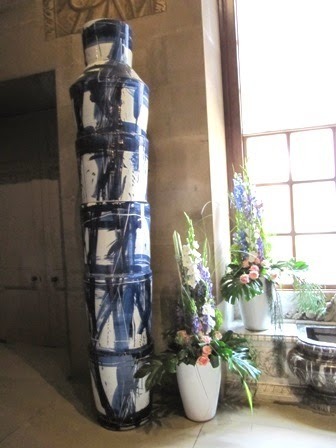 I was particularly taken with this unusual combination, that used the beautiful blue and white containers all stacked on top of each other.
I was particularly taken with this unusual combination, that used the beautiful blue and white containers all stacked on top of each other.
The dining room, always a great favourite of mine, and frequently changing, this time was laid out as it was for the visit of King George V and Queen Mary in 1933. This was one of the last great dinners held at Chatsworth before the onset of the Second World War.
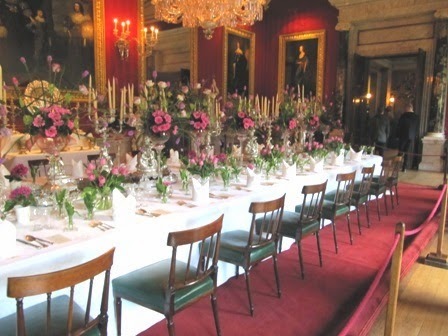
 However, the arrangement that caught my eye the most, and was certainly the most memorable, if not the most attractive, was a matching pair of great orbits and cascading flowers either side of Damien's Hirst's incredible statue. Titled 'St Bartholomew, Exquisite Pain' it was created in 2006 especially for the Beyond Limits-Sotheby's annual exhibition of modern sculpture held at Chatsworth. I felt a great deal of thought had gone into this creation and it worked most effectively.
However, the arrangement that caught my eye the most, and was certainly the most memorable, if not the most attractive, was a matching pair of great orbits and cascading flowers either side of Damien's Hirst's incredible statue. Titled 'St Bartholomew, Exquisite Pain' it was created in 2006 especially for the Beyond Limits-Sotheby's annual exhibition of modern sculpture held at Chatsworth. I felt a great deal of thought had gone into this creation and it worked most effectively.
I enjoyed this exhibition so much - it just gets better and better each year, and all credit should go to Jonathan and his amazing band of skilled volunteers.
Now I can't wait to see what they come up with next year!


 This annual event, organised by talented flower-arranger Jonathan Moseley, is a high-light of my year, and something I wouldn't dream of missing.
This annual event, organised by talented flower-arranger Jonathan Moseley, is a high-light of my year, and something I wouldn't dream of missing.This year the theme was the direct link between art and flowers, ranging from the ancient Egyptians to contemporary artists of the 21st century.
There were literally dozens of arrangements - in fact they were everywhere you looked, and all exquisite and beautiful.
 I was particularly taken with this unusual combination, that used the beautiful blue and white containers all stacked on top of each other.
I was particularly taken with this unusual combination, that used the beautiful blue and white containers all stacked on top of each other.The dining room, always a great favourite of mine, and frequently changing, this time was laid out as it was for the visit of King George V and Queen Mary in 1933. This was one of the last great dinners held at Chatsworth before the onset of the Second World War.

 However, the arrangement that caught my eye the most, and was certainly the most memorable, if not the most attractive, was a matching pair of great orbits and cascading flowers either side of Damien's Hirst's incredible statue. Titled 'St Bartholomew, Exquisite Pain' it was created in 2006 especially for the Beyond Limits-Sotheby's annual exhibition of modern sculpture held at Chatsworth. I felt a great deal of thought had gone into this creation and it worked most effectively.
However, the arrangement that caught my eye the most, and was certainly the most memorable, if not the most attractive, was a matching pair of great orbits and cascading flowers either side of Damien's Hirst's incredible statue. Titled 'St Bartholomew, Exquisite Pain' it was created in 2006 especially for the Beyond Limits-Sotheby's annual exhibition of modern sculpture held at Chatsworth. I felt a great deal of thought had gone into this creation and it worked most effectively.I enjoyed this exhibition so much - it just gets better and better each year, and all credit should go to Jonathan and his amazing band of skilled volunteers.
Now I can't wait to see what they come up with next year!


Published on May 10, 2014 03:28
May 7, 2014
'Forever Green' cafe - Ransom Wood - Mansfield - Nottinghamshire
http://www.aboutnottinghamshire.co.uk/
Ransom Wood is located just outside Mansfield in Nottinghamshire, and is considered to be part of Sherwood Forest. At the turn of the 20th century it was developed into a hospital primarily for miners, when it was considered the best treatment for lung diseases was fresh air, with patients' beds wheeled outside, even in the winter months. Accommodation was also built for the staff, resulting in around 20 quite substantial buildings. Heating was provided from a central coal boiler which fed into an underground network of pipes, of which at least half a mile still exists, and these are large enough to walk through!
Unfortunately, despite a considerable search, I was unable to locate any photographs of the hospital, but for an account of what it was like to be a patient just click here
The hospital continued to serve the local community becoming part of the National Health Service. Eventually health facilities were centralised and in 1990 the site was sold to Mansfield Sand Company, until Ransomewood Estates (the business name for the company who own Ransom Wood) was form in 1997 and they set about developing it into the thriving area it is today, employing hundreds of people.
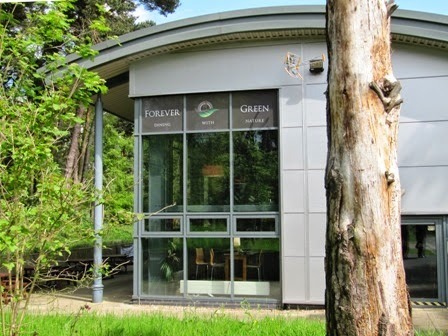 'Forevergreen' Cafe is just one of the many enterprises. Incredibly, whilst a substantial new build, it is almost impossible to spot it from the road! This photo was the first opportunity I had to view it, and I was almost on top of it then!
'Forevergreen' Cafe is just one of the many enterprises. Incredibly, whilst a substantial new build, it is almost impossible to spot it from the road! This photo was the first opportunity I had to view it, and I was almost on top of it then!
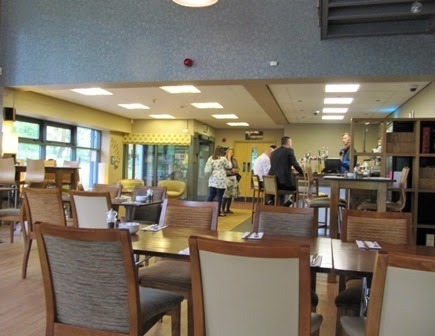 Inside there is a two-storey glass window looking out over the woodland, and other people have written on the web about watching fallow deer whilst they ate their lunch! I had to content myself with the many bird feeders just outside which were certainly being well used!
Inside there is a two-storey glass window looking out over the woodland, and other people have written on the web about watching fallow deer whilst they ate their lunch! I had to content myself with the many bird feeders just outside which were certainly being well used!
I found the staff friendly and approachable, and whilst the service did seem a little slow there was so much to watch it was unimportant. I only had an omlette, but it was still a substantial meal, and the choice on the menu was impressive.
 Something that did amuse me, giving the rural setting of the place was this delightful toilet sign!
Something that did amuse me, giving the rural setting of the place was this delightful toilet sign!

I certainly look forward to returning in the not-too-distant future.

Ransom Wood is located just outside Mansfield in Nottinghamshire, and is considered to be part of Sherwood Forest. At the turn of the 20th century it was developed into a hospital primarily for miners, when it was considered the best treatment for lung diseases was fresh air, with patients' beds wheeled outside, even in the winter months. Accommodation was also built for the staff, resulting in around 20 quite substantial buildings. Heating was provided from a central coal boiler which fed into an underground network of pipes, of which at least half a mile still exists, and these are large enough to walk through!
Unfortunately, despite a considerable search, I was unable to locate any photographs of the hospital, but for an account of what it was like to be a patient just click here
The hospital continued to serve the local community becoming part of the National Health Service. Eventually health facilities were centralised and in 1990 the site was sold to Mansfield Sand Company, until Ransomewood Estates (the business name for the company who own Ransom Wood) was form in 1997 and they set about developing it into the thriving area it is today, employing hundreds of people.
 'Forevergreen' Cafe is just one of the many enterprises. Incredibly, whilst a substantial new build, it is almost impossible to spot it from the road! This photo was the first opportunity I had to view it, and I was almost on top of it then!
'Forevergreen' Cafe is just one of the many enterprises. Incredibly, whilst a substantial new build, it is almost impossible to spot it from the road! This photo was the first opportunity I had to view it, and I was almost on top of it then! Inside there is a two-storey glass window looking out over the woodland, and other people have written on the web about watching fallow deer whilst they ate their lunch! I had to content myself with the many bird feeders just outside which were certainly being well used!
Inside there is a two-storey glass window looking out over the woodland, and other people have written on the web about watching fallow deer whilst they ate their lunch! I had to content myself with the many bird feeders just outside which were certainly being well used!I found the staff friendly and approachable, and whilst the service did seem a little slow there was so much to watch it was unimportant. I only had an omlette, but it was still a substantial meal, and the choice on the menu was impressive.
 Something that did amuse me, giving the rural setting of the place was this delightful toilet sign!
Something that did amuse me, giving the rural setting of the place was this delightful toilet sign!

I certainly look forward to returning in the not-too-distant future.

Published on May 07, 2014 06:52
May 1, 2014
Walled garden - Brackenhurst - Southwell - Nottinghamshire
http://www.aboutnottinghamshire.co.uk/
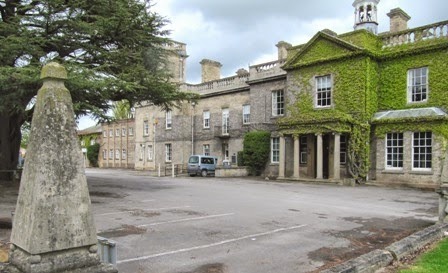 This striking place is on a hill just outside the delightful Minster town of Southwell. Brackenhurst Hall was built for the Rev. Thomas Coat Cane in 1828, and eventually ended up being owned by William Norton Hicking, who purchased it in 1889. He expanded the house and added the roof balustrades, chimneys and the tower.
This striking place is on a hill just outside the delightful Minster town of Southwell. Brackenhurst Hall was built for the Rev. Thomas Coat Cane in 1828, and eventually ended up being owned by William Norton Hicking, who purchased it in 1889. He expanded the house and added the roof balustrades, chimneys and the tower.
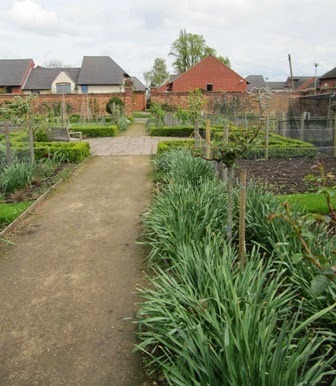 The area that particularly interested me was the Walled Garden, which is still in full production. Against the Victorian wall was this interesting, sloping glassed area for extensive fruit production.
The area that particularly interested me was the Walled Garden, which is still in full production. Against the Victorian wall was this interesting, sloping glassed area for extensive fruit production.
 The remainder of the gardens are in the style of Sir Edwin Lutyens and are examples of the classical arts and crafts movement. The rose garden was added in 1928 with |Italian tiles being imported for the pergola.
The remainder of the gardens are in the style of Sir Edwin Lutyens and are examples of the classical arts and crafts movement. The rose garden was added in 1928 with |Italian tiles being imported for the pergola.
 There is also a small lake, added around 1928 which has a delightful 'Willow Pattern' curved bridge and a little summerhouse behind it.
There is also a small lake, added around 1928 which has a delightful 'Willow Pattern' curved bridge and a little summerhouse behind it.
Not surprising Brackenhurst hall, the coach house, the orangery and the walled garden wall are all Grade II English Heritage listed structures. This listing requires all developments to the structures to retain their historic values due to the structures being on national importance.
I certainly enjoyed strolling round this very special area which is now an educational institution having merged with Nottingham Trent University as the school of Animal, Rural and Environmental Sciences.
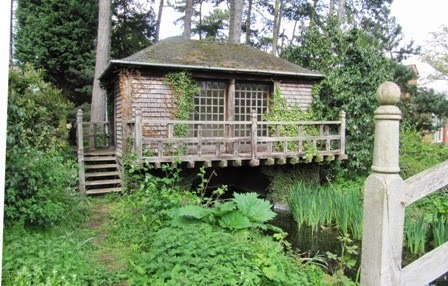
What a lovely place both to study and to live!

 This striking place is on a hill just outside the delightful Minster town of Southwell. Brackenhurst Hall was built for the Rev. Thomas Coat Cane in 1828, and eventually ended up being owned by William Norton Hicking, who purchased it in 1889. He expanded the house and added the roof balustrades, chimneys and the tower.
This striking place is on a hill just outside the delightful Minster town of Southwell. Brackenhurst Hall was built for the Rev. Thomas Coat Cane in 1828, and eventually ended up being owned by William Norton Hicking, who purchased it in 1889. He expanded the house and added the roof balustrades, chimneys and the tower. The area that particularly interested me was the Walled Garden, which is still in full production. Against the Victorian wall was this interesting, sloping glassed area for extensive fruit production.
The area that particularly interested me was the Walled Garden, which is still in full production. Against the Victorian wall was this interesting, sloping glassed area for extensive fruit production.
 The remainder of the gardens are in the style of Sir Edwin Lutyens and are examples of the classical arts and crafts movement. The rose garden was added in 1928 with |Italian tiles being imported for the pergola.
The remainder of the gardens are in the style of Sir Edwin Lutyens and are examples of the classical arts and crafts movement. The rose garden was added in 1928 with |Italian tiles being imported for the pergola. There is also a small lake, added around 1928 which has a delightful 'Willow Pattern' curved bridge and a little summerhouse behind it.
There is also a small lake, added around 1928 which has a delightful 'Willow Pattern' curved bridge and a little summerhouse behind it.Not surprising Brackenhurst hall, the coach house, the orangery and the walled garden wall are all Grade II English Heritage listed structures. This listing requires all developments to the structures to retain their historic values due to the structures being on national importance.
I certainly enjoyed strolling round this very special area which is now an educational institution having merged with Nottingham Trent University as the school of Animal, Rural and Environmental Sciences.

What a lovely place both to study and to live!

Published on May 01, 2014 05:44
April 22, 2014
Minature Train - Rother Valley Country Park - Rotherham - Yorkshire
http://www.aboutnottinghamshire.co.uk/
I just love this place - see previous blog
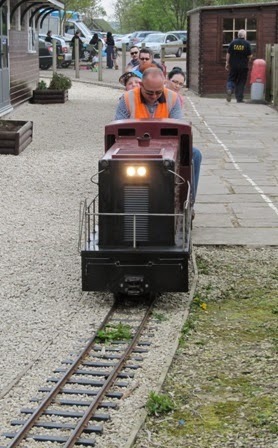 This time, to my considerable delight the little minature railway was running. It was opened about 5 years ago and is home to Basil the Diesel train! He runs on a seven and a quarter inch track which is 800m long. It runs alongside the main lake and there is enough room for 26 people. There is also a special little carriage for wheelchair users, pushchair users and dog walkers.
This time, to my considerable delight the little minature railway was running. It was opened about 5 years ago and is home to Basil the Diesel train! He runs on a seven and a quarter inch track which is 800m long. It runs alongside the main lake and there is enough room for 26 people. There is also a special little carriage for wheelchair users, pushchair users and dog walkers.
There is a stop at the top of the lake, and then it was back along the track to a station near the car park and the visitor facilities. It was so lovely to see the scenery from this different viewpoint that it was hard to imagine that the area had been used for opencast mining for coal from 1976 til 1981 when 1.7 million tons of coal was extracted.
Highly recommended for a fun day out!

I just love this place - see previous blog
 This time, to my considerable delight the little minature railway was running. It was opened about 5 years ago and is home to Basil the Diesel train! He runs on a seven and a quarter inch track which is 800m long. It runs alongside the main lake and there is enough room for 26 people. There is also a special little carriage for wheelchair users, pushchair users and dog walkers.
This time, to my considerable delight the little minature railway was running. It was opened about 5 years ago and is home to Basil the Diesel train! He runs on a seven and a quarter inch track which is 800m long. It runs alongside the main lake and there is enough room for 26 people. There is also a special little carriage for wheelchair users, pushchair users and dog walkers.There is a stop at the top of the lake, and then it was back along the track to a station near the car park and the visitor facilities. It was so lovely to see the scenery from this different viewpoint that it was hard to imagine that the area had been used for opencast mining for coal from 1976 til 1981 when 1.7 million tons of coal was extracted.
Highly recommended for a fun day out!

Published on April 22, 2014 02:23
April 18, 2014
Idle Valley Nature Reserve - north Nottinghamshire
http://www.aboutnottinghamshire.co.uk/
 This amazing area, full of lakes, used to be used by Tarmac Limited for the extraction of gravel and other aggregates. They then turned it over to the Nottinghamshire Wildlife Trust, and for more than 20 years this fine organisation have been working on improving this Site of Special Scientific Interest - quite some task as it covers an area of around 450 hectares of lakes, wetland, grassland and scrub.
This amazing area, full of lakes, used to be used by Tarmac Limited for the extraction of gravel and other aggregates. They then turned it over to the Nottinghamshire Wildlife Trust, and for more than 20 years this fine organisation have been working on improving this Site of Special Scientific Interest - quite some task as it covers an area of around 450 hectares of lakes, wetland, grassland and scrub.
You get to the site via the A638, and I don't think it's too well signed!
 On arriving the first thing you see is a squat building tucked into the landscape. This is the Visitor Centre, which has huge windows on the side overlooking the lake. There's a small shop, cafe, and a number of rooms for meetings, talks etc. I've always found the people on duty here are exceptionally friendly and knowledgeable.
On arriving the first thing you see is a squat building tucked into the landscape. This is the Visitor Centre, which has huge windows on the side overlooking the lake. There's a small shop, cafe, and a number of rooms for meetings, talks etc. I've always found the people on duty here are exceptionally friendly and knowledgeable.
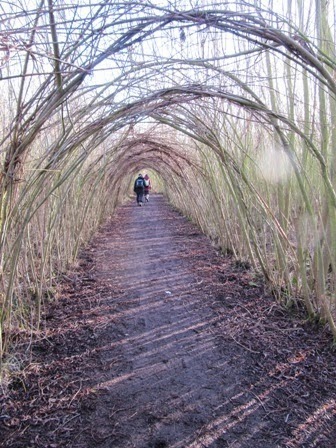 Then it's out to start exploring this vast site. One of my favourite bits is the walk through the willow tunnel - the longest I've ever seen, and it must have taken some work to construct it.
Then it's out to start exploring this vast site. One of my favourite bits is the walk through the willow tunnel - the longest I've ever seen, and it must have taken some work to construct it.
 Then there are a number of clearly marked walks of differing lengths - in fact there's something for everyone at Idle Valley, and it's not just lakes with their numerous waterfowl, but the River Idle as well. In fact the reserve is over 3 miles long from the northernmost tip to the southern base. It is the 5th largest area of Special Scientific Interest in the county and more than 250 bird species have been recorded. (I live in hope of one day seeing a kingfisher!) No wonder it is one of the top birding sites in the country, and is considered of national importance.
Then there are a number of clearly marked walks of differing lengths - in fact there's something for everyone at Idle Valley, and it's not just lakes with their numerous waterfowl, but the River Idle as well. In fact the reserve is over 3 miles long from the northernmost tip to the southern base. It is the 5th largest area of Special Scientific Interest in the county and more than 250 bird species have been recorded. (I live in hope of one day seeing a kingfisher!) No wonder it is one of the top birding sites in the country, and is considered of national importance.
No wonder it's one of my favourite places to visit! (The food is pretty good too!)


 This amazing area, full of lakes, used to be used by Tarmac Limited for the extraction of gravel and other aggregates. They then turned it over to the Nottinghamshire Wildlife Trust, and for more than 20 years this fine organisation have been working on improving this Site of Special Scientific Interest - quite some task as it covers an area of around 450 hectares of lakes, wetland, grassland and scrub.
This amazing area, full of lakes, used to be used by Tarmac Limited for the extraction of gravel and other aggregates. They then turned it over to the Nottinghamshire Wildlife Trust, and for more than 20 years this fine organisation have been working on improving this Site of Special Scientific Interest - quite some task as it covers an area of around 450 hectares of lakes, wetland, grassland and scrub.You get to the site via the A638, and I don't think it's too well signed!
 On arriving the first thing you see is a squat building tucked into the landscape. This is the Visitor Centre, which has huge windows on the side overlooking the lake. There's a small shop, cafe, and a number of rooms for meetings, talks etc. I've always found the people on duty here are exceptionally friendly and knowledgeable.
On arriving the first thing you see is a squat building tucked into the landscape. This is the Visitor Centre, which has huge windows on the side overlooking the lake. There's a small shop, cafe, and a number of rooms for meetings, talks etc. I've always found the people on duty here are exceptionally friendly and knowledgeable. Then it's out to start exploring this vast site. One of my favourite bits is the walk through the willow tunnel - the longest I've ever seen, and it must have taken some work to construct it.
Then it's out to start exploring this vast site. One of my favourite bits is the walk through the willow tunnel - the longest I've ever seen, and it must have taken some work to construct it. Then there are a number of clearly marked walks of differing lengths - in fact there's something for everyone at Idle Valley, and it's not just lakes with their numerous waterfowl, but the River Idle as well. In fact the reserve is over 3 miles long from the northernmost tip to the southern base. It is the 5th largest area of Special Scientific Interest in the county and more than 250 bird species have been recorded. (I live in hope of one day seeing a kingfisher!) No wonder it is one of the top birding sites in the country, and is considered of national importance.
Then there are a number of clearly marked walks of differing lengths - in fact there's something for everyone at Idle Valley, and it's not just lakes with their numerous waterfowl, but the River Idle as well. In fact the reserve is over 3 miles long from the northernmost tip to the southern base. It is the 5th largest area of Special Scientific Interest in the county and more than 250 bird species have been recorded. (I live in hope of one day seeing a kingfisher!) No wonder it is one of the top birding sites in the country, and is considered of national importance. No wonder it's one of my favourite places to visit! (The food is pretty good too!)


Published on April 18, 2014 00:46
April 10, 2014
Navvies on the Dore & Chinley Railway - lecture - Chesterfield - Derbyshire
http://www.aboutnottinghamshire.co.uk/
I just love tunnels - especially those over railway lines! I sit there thinking "How did they do this? Who were they? Where did they live?"
Consequently when I saw a poster advertising a talk by Clive Leivers about 'Navvies on the Dore & Chinley Railway' being given at the Chesterfield Labour Club I just had to be there!
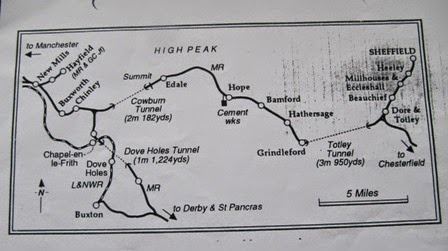 As if that wasn't enough Mr Leivers had also provided a large number of hand-outs, which he kindly said I could take and these form the basis for this blog, and all the illustrations, for which I am very grateful.
As if that wasn't enough Mr Leivers had also provided a large number of hand-outs, which he kindly said I could take and these form the basis for this blog, and all the illustrations, for which I am very grateful.
Leaving Sheffield railway station going west towards Manchester there are the most marvellous tunnels! The first one, that ends near Grindleford is 3 miles 950 yards long, and seems to go on forever! Further along the track, going through the High Peak area of Derbyshire is the shorter Cowburn Tunnel, just 2 miles 182 yards long.
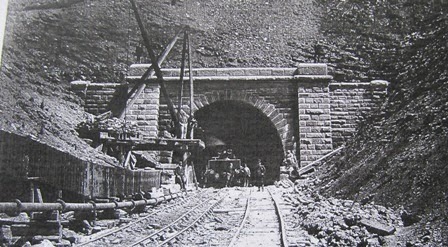 It was started in 1888, the line being over 20 miles long,and proved one of the most difficult in England to construct. The two tunnels meant that more than a quarter of the line is underground.
It was started in 1888, the line being over 20 miles long,and proved one of the most difficult in England to construct. The two tunnels meant that more than a quarter of the line is underground.
Mr Leivers had researched the occupations of those employed on this railway and interestingly there were 79 navvies, 184 railway labourers and 118 miners amongst the 476 men employed on the line. There were also 134 Craftsmen, including 26 brickmakers/bricklayers, 20 engine drivers and 44 stone masons - the latter apparently for bridge and tunnel entrance work.
Also it proved a myth that all navvies came from Ireland, for Mr Leivers analysis showed a surprisingly wide distribution, and whilst 39.4% came from the east midlands, so were presumably local people, others had come from as far away as East Anglia, and 26.5% from the south east.

 One thing I found very interesting was the huge importance of the Railway Mission. It was founded in 1881 with the intention of spreading the Christian Gospel to people working in the railways. One important aspect of their work was the publication of a magazine that advertised where the next line was being built, and as the workers were mainly itinerant this determined their next location.
One thing I found very interesting was the huge importance of the Railway Mission. It was founded in 1881 with the intention of spreading the Christian Gospel to people working in the railways. One important aspect of their work was the publication of a magazine that advertised where the next line was being built, and as the workers were mainly itinerant this determined their next location.
The conditions both at work and at home were generally pretty appalling, and whilst they mostly lodged with nearby fellow workers, the numbers using the same beds was staggering! Some also slept in rough sheds and inadequate shacks, and Inspectors feared there would be a cholera outbreak due to the complete lack of sanitary provisions. In fact there was a serious smallpox outbreak in 1893, with 23 cases, and 4 fatalities. Eventually a small hut had to be used as an Isolation Hospital.
 One thing that always marks the quality of a good lecture is how many people wanted to know more! One person asked if local businesses had benefited from the huge influx of workers on the railway, with Edale alone going from 336 in 1881, to nearly a thousand during the construction work. In this delightful photograph you can see eager children getting fish and chips from an enterprising van!
One thing that always marks the quality of a good lecture is how many people wanted to know more! One person asked if local businesses had benefited from the huge influx of workers on the railway, with Edale alone going from 336 in 1881, to nearly a thousand during the construction work. In this delightful photograph you can see eager children getting fish and chips from an enterprising van!
There was also a question as to whether any of the workers had married local girls. Mr. Leivers said it was hard to research this sort of thing, although there was a known case where a man from the south of England had certainly wed a local girl and settled in the area. They had twins, and called the girl Dore and the boy Chinley! The girl did not survive, but the man grew to be well-known in the area!
I found this lecture absolutely fascinating and was so glad I'd made the effort to attend. In fact there was so much interesting information I would quite like to hear Mr. Leivers again as I'm sure there are some details I missed!

I just love tunnels - especially those over railway lines! I sit there thinking "How did they do this? Who were they? Where did they live?"
Consequently when I saw a poster advertising a talk by Clive Leivers about 'Navvies on the Dore & Chinley Railway' being given at the Chesterfield Labour Club I just had to be there!
 As if that wasn't enough Mr Leivers had also provided a large number of hand-outs, which he kindly said I could take and these form the basis for this blog, and all the illustrations, for which I am very grateful.
As if that wasn't enough Mr Leivers had also provided a large number of hand-outs, which he kindly said I could take and these form the basis for this blog, and all the illustrations, for which I am very grateful.Leaving Sheffield railway station going west towards Manchester there are the most marvellous tunnels! The first one, that ends near Grindleford is 3 miles 950 yards long, and seems to go on forever! Further along the track, going through the High Peak area of Derbyshire is the shorter Cowburn Tunnel, just 2 miles 182 yards long.
 It was started in 1888, the line being over 20 miles long,and proved one of the most difficult in England to construct. The two tunnels meant that more than a quarter of the line is underground.
It was started in 1888, the line being over 20 miles long,and proved one of the most difficult in England to construct. The two tunnels meant that more than a quarter of the line is underground.Mr Leivers had researched the occupations of those employed on this railway and interestingly there were 79 navvies, 184 railway labourers and 118 miners amongst the 476 men employed on the line. There were also 134 Craftsmen, including 26 brickmakers/bricklayers, 20 engine drivers and 44 stone masons - the latter apparently for bridge and tunnel entrance work.
Also it proved a myth that all navvies came from Ireland, for Mr Leivers analysis showed a surprisingly wide distribution, and whilst 39.4% came from the east midlands, so were presumably local people, others had come from as far away as East Anglia, and 26.5% from the south east.

 One thing I found very interesting was the huge importance of the Railway Mission. It was founded in 1881 with the intention of spreading the Christian Gospel to people working in the railways. One important aspect of their work was the publication of a magazine that advertised where the next line was being built, and as the workers were mainly itinerant this determined their next location.
One thing I found very interesting was the huge importance of the Railway Mission. It was founded in 1881 with the intention of spreading the Christian Gospel to people working in the railways. One important aspect of their work was the publication of a magazine that advertised where the next line was being built, and as the workers were mainly itinerant this determined their next location.The conditions both at work and at home were generally pretty appalling, and whilst they mostly lodged with nearby fellow workers, the numbers using the same beds was staggering! Some also slept in rough sheds and inadequate shacks, and Inspectors feared there would be a cholera outbreak due to the complete lack of sanitary provisions. In fact there was a serious smallpox outbreak in 1893, with 23 cases, and 4 fatalities. Eventually a small hut had to be used as an Isolation Hospital.
 One thing that always marks the quality of a good lecture is how many people wanted to know more! One person asked if local businesses had benefited from the huge influx of workers on the railway, with Edale alone going from 336 in 1881, to nearly a thousand during the construction work. In this delightful photograph you can see eager children getting fish and chips from an enterprising van!
One thing that always marks the quality of a good lecture is how many people wanted to know more! One person asked if local businesses had benefited from the huge influx of workers on the railway, with Edale alone going from 336 in 1881, to nearly a thousand during the construction work. In this delightful photograph you can see eager children getting fish and chips from an enterprising van!There was also a question as to whether any of the workers had married local girls. Mr. Leivers said it was hard to research this sort of thing, although there was a known case where a man from the south of England had certainly wed a local girl and settled in the area. They had twins, and called the girl Dore and the boy Chinley! The girl did not survive, but the man grew to be well-known in the area!
I found this lecture absolutely fascinating and was so glad I'd made the effort to attend. In fact there was so much interesting information I would quite like to hear Mr. Leivers again as I'm sure there are some details I missed!

Published on April 10, 2014 03:53
March 30, 2014
Penguins - The Deep - Hull - Yorkshire
http://www.aboutnottinghamshire.co.uk/
This was my second visit to 'The Deep' an amazing aquarium attraction in Hull (see previous blog). Now I wanted to see the newly arrived penguins!
There are five of them, four males named Michael Angelo, Donatello, Leonardo and Raphael. The female is Fiona. They have all come from the Moody Gardens Zoo in Texas.
Their special exhibit area has cost £750,000 and is the only location in the north of England where you can see these creatures. It covers three floors and features a swimming pool, diving pool, beach area, nesting area, and apparently an outdoor balcony with views overlooking the River Humber, although I never found this!
The exhibit is built to look like Grytviken, an abandoned whaling port in South Georgia, Antarctica. It was taken over by Gentoo penguins in the last 1960s following the demise of the whaling industry, and has been very well done.
However, I was a bit disappointed that the viewing windows were quite small, and there were such
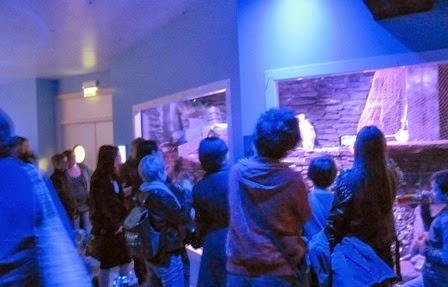 vast crowds. Admittedly I had gone on a Saturday, between 12 and 2, but it was a case of queuing to get everywhere - even to get inside despite having pre-booked tickets. I then queued to see the penguins in both locations and of course the toilets!
vast crowds. Admittedly I had gone on a Saturday, between 12 and 2, but it was a case of queuing to get everywhere - even to get inside despite having pre-booked tickets. I then queued to see the penguins in both locations and of course the toilets! 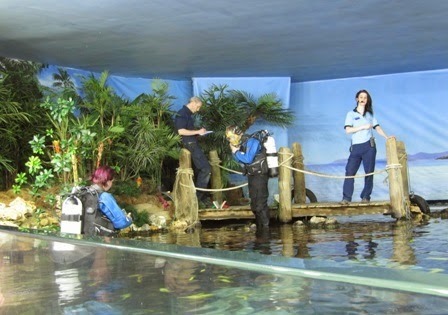 After I'd seen the penguins I wanted to go back to see the divers at work cleaning the glass and feeding the fish in the Lagoon of Light, which is a really amazing area. However, it did seem that the only way to get there was to go against the crowd, and fight my way back upstairs to this area. Then it would have been better if the amplification on the girl's mic had been better and we could have actually heard what she said, as I'm sure that would have been really interesting.
After I'd seen the penguins I wanted to go back to see the divers at work cleaning the glass and feeding the fish in the Lagoon of Light, which is a really amazing area. However, it did seem that the only way to get there was to go against the crowd, and fight my way back upstairs to this area. Then it would have been better if the amplification on the girl's mic had been better and we could have actually heard what she said, as I'm sure that would have been really interesting.By now I was ready for a much needed cuppa, but again it did seem that the only way back to the cafe in the entrance was to retrace my steps and again fight against the crowds, which did seem somewhat less than satisfactory.
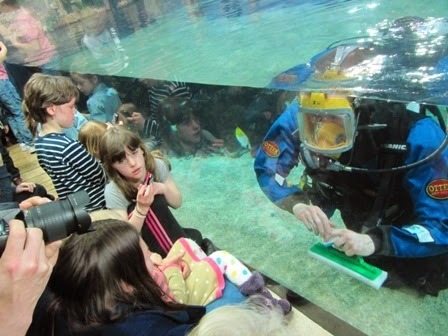
Generally this is the most amazing place with excellent exhibits, clear information boards, and easy walkways.
I would just suggest that you don't visit during peak times or school holidays!

Published on March 30, 2014 04:22



